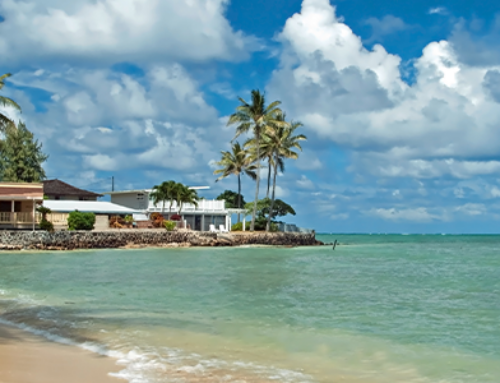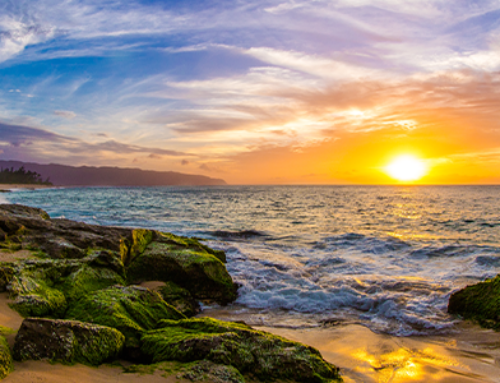Being an isolated archipelago has its perks. Hawaii’s remote position in the Pacific Ocean has given its flora and fauna a unique advantage: Many species have been left alone to evolve to their particular environment without a great deal of outside interference.
As a result, Hawaii and its surrounding waters are home to a tremendous number of species—21,383, to be exact. Of those, 8,759 are endemic to the Hawaiian islands, meaning you won’t find them anywhere else in the world. The state’s visitors and residents already know just how special Hawaii can be, and its biodiversity is just another reason to love the Aloha State.
This extraordinary biodiversity also extends to the birds you’ll find in Hawaii. In this article, we’ll highlight eight of our favorite native avian inhabitants, as well as their unique characteristics.
To be clear, “native” means that these species got here without human influence. But before we introduce you to our favorite eight, let’s answer the big question on most people’s minds when we talk about native species in Hawaii…
How the Heck Did Native Birds Get to Hawaii?
We’ve all heard stories of travelers from abroad bringing species to Hawaii. One of the most familiar examples would be Captain George Vancouver’s gift of long-horn cattle to King Kamehameha in 1793, which kicked off paniolo culture in Hawaii. Other species, like the myna bird, were brought to Hawaii to control pests.
However, to be considered “native,” a species needs to have arrived to the Hawaiian islands on its own—without human interference. Considering Hawaii’s out-of-the-way location (the nearest landmass is 1,500-2,000 miles away, depending on which part of the state you measure from), it’s hard to conceive of a species arriving here on its own.
Scientists believe the first birds, members of the finch species, flew to Hawaii about 8 million years ago from Asia. This timeline gave these original avian ancestors enough runway to evolve into more than 50 distinct species!
But how did these birds fly thousands of miles—and in enough numbers—to establish an entirely new settlement in the Hawaiian islands? One evolutionary biologist, Dr. Heather Lerner, credits it to what’s called “irruption.” Rosefinches often migrate in large groups to new locations far away from their current homes, often staying to breed in those new areas. In her estimation, thousands—or even tens of thousands of birds—could possibly have been caught in a storm during their migration and ended up in the Hawaiian islands.
From there, they established a new home and began to evolve into the group of birds we know today as Hawaiian honeycreepers.
One more fascinating discovery to keep in mind: It’s very possible that we’re seeing only a fraction of the species that once existed in Hawaii. A pair of Smithsonian researchers have discovered more than 50 species of extinct birds in the Hawaiian islands. They suspect that the first human arrivals to the islands, as well as the dogs and pigs they brought with them, may have caused the extinction of these species.
Ultimately, this only leaves us to wonder: What other remarkable native species might have existed on Hawaii, pre-human contact? We can only speculate!
Now, let’s take a closer look at the Hawaiian honeycreeper, an extraordinary example of how millions of years of evolution can produce wildly beautiful and diverse species.
Meet the Hawaiian Honeycreeper
Birds carrying special significance in the Hawaiian culture—and feature prominently in Hawaiian stories and myths. The feathers of these birds play a particularly important role. As you’ll see, many of these birds, like the ‘i’iwi, sport vibrantly-colored plumage, which were woven into cloaks, helmets, and leis worn by Hawaiian nobility.
However, to scientists, the Hawaiian honeycreeper means something entirely different: They’re the ultimate example of evolution on display, as their coloring and bills evolved to suit their particular environment. However, despite their diversity, honeycreepers tend to share a few characteristics:
- Many feed on nectar and are especially attracted to the flowers of the ohia. Others eat seeds, fruit, or snails.
- Most have distinctive, brightly-colored feathers.
- Many have a particular smell, which has been described as something like “old canvas tents.”
(By the way, if you ever get close enough to smell a honeycreeper, that’s a uniquely Hawaiian experience you should treasure!)
Now let’s take a look at a few of the honeycreepers you might see in Hawaii today—and how diverse they’ve become over the last few million years:
‘I’iwi: The Scarlet Honeycreeper
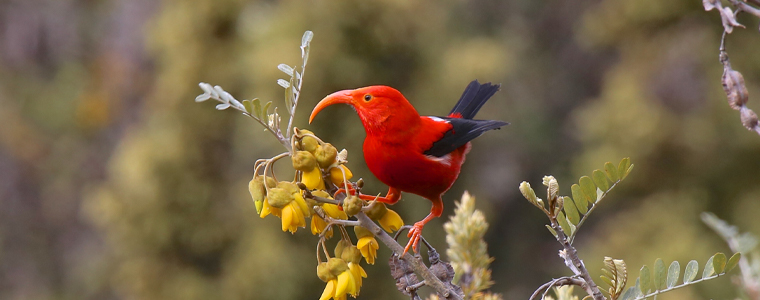
The ‘i’iwi is probably the most recognizable of the Hawaiian honeycreepers, and it was one of the most common Hawaii forest birds at one point. Its curved beak is uniquely suited for sipping nectar from flowers. While ‘i’iwi can be found all across the Hawaiian archipelago, its numbers are declining as a result of avian malaria and avian pox, transmitted by mosquitos.x ‘I’iwi are also known to eat spiders and other insects, and they commonly migrate up and down elevations to stay close to their food sources throughout the year. Interestingly enough, this species continues to evolve as it adapts to its environment. ‘I’iwi bills have, on average, shortened by half a millimeter over the last hundred years, as its main source of food, the endangered lobeloid flower, has disappeared. Instead, ‘i’iwi, have turned to the ohia tree, whose blossoms are much shorter and more accessible than the long, curved blooms of the lobeloid.
‘Apapane
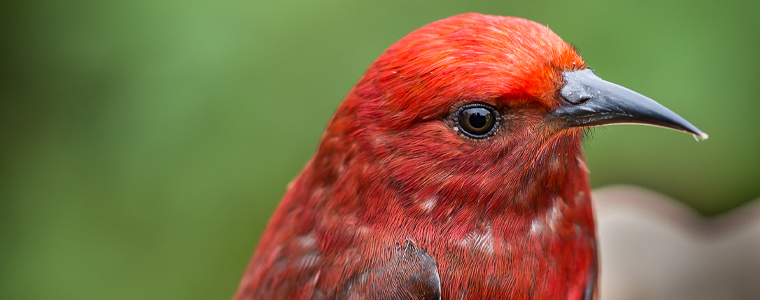
While ‘apapane share some of the scarlet plumage of their ‘i’iwi cousins, they’re easily distinguished by their shorter, straighter bill. Although you’ll find this bird across the Hawaiian island chain, nearly 80% of the population lives on the Big Island in high-elevation ohia forests, where they dine on the flowers’ nectar.xi If you happen to glimpse one of these birds in the wild, you may notice that its face has a yellowish cast, which is often just a dusting of pollen from ducking their heads into a tasty flower.xii
‘Akiapola’au
Nicknamed the “aki,” this Hawaiian honeycreeper has a unique bill comprised of two parts:
A lower section that it uses to hammer bark like a woodpecker
A curved upper section it uses to pull insects out of the holes it’s created.
Found only on the Big Island, current population estimates sit around 1,200 for this bird. However, efforts by the Hakalau Forest National Wildlife Refuge have been assisting in restoring the aki population. Interestingly enough, while other young songbirds are ready to leave their nests after a few weeks, the aki may tend to their young for almost a year.
‘Amakihi
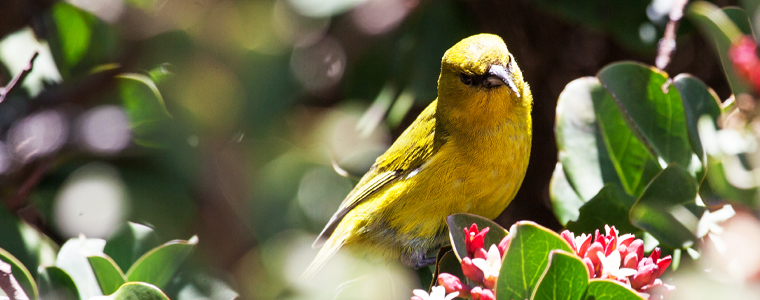
Found on Maui, Molokai, and the Big Island, the ‘amakihi is among the most common native songbirds in Hawaii. Despite its relatively small size—a little over four inches long—some say you can hear its powerful chirps for miles. Whereas the ‘i’iwi has been driven to higher elevations to avoid mosquito-borne illnesses, the ‘amakihi is still found at lower elevations, suggesting that the population may be building tolerance to avian malaria and pox. As a testament to their hardiness, ‘amakihi will feed on a number of diets: insects, tree sap, nectar, and even fruits.
We’ll finish with a fun fact about this extraordinary family of birds: A group of honeycreepers is called a “hive.” Store that away for your next trivia night!
Now, let’s talk about four other native birds you’d be lucky to encounter in Hawaii.
Manu-o-Ku: The White Tern
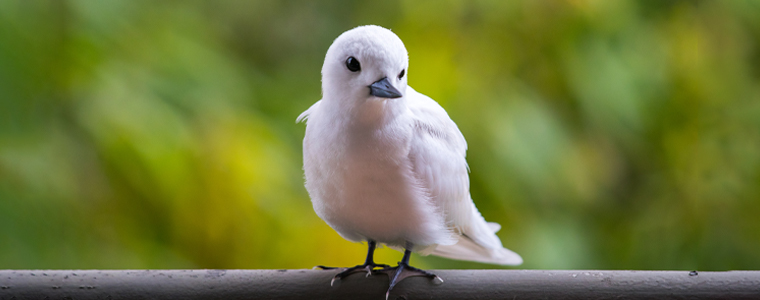
Often called the “fairy tern” for its ability to hover in the air, the white tern is also, interestingly enough, the official bird of Honolulu. For whatever reason, this bird has discovered the ability to thrive in the urban zones of Oahu. Perhaps Honolulu’s proximity to the water influenced its choice of habitat: The birds primarily eat whole fish and squid, which they pack into their bill and bring back to feed their young.
Nene: The Hawaiian Goose

The official state bird of Hawaii comes with an interesting history. Scientists believe that the nene’s original ancestor was Branta canadensis, the Canada goose, which likely arrived in the Hawaiian islands nearly 500,000 years ago. As with many Hawaiian birds, the nene was named onomatopoeically. In other words, the goose’s call sounds like it’s saying “nene.” Others have noted that nene are also capable of making a sound awfully similar to the mooing of a cow. Unlike many other species of goose, the nene have feet that are uniquely adapted to life on land, with long toes that make it easier to grip the landscape as they move around. Although nene were once endangered, its numbers are currently on the rise, thanks to conservation efforts, so you’ll likely get the chance to view these unique creatures in person.
I’o: The Hawaiian Hawk
This majestic bird is found only on the Big Island, and it’s the only endemic hawk species found in the Hawaiian islands. In Hawaiian culture, the hawk was considered a symbol of royalty, and harming or killing one was strictly forbidden. As with the nene, the i’o gets its name from its distinctive screechy call. Although the i’o is often found in solitary situations, when hawks do gather (mostly to migrate), that flock is called a “kettle.”
Pueo: The Hawaiian Short-Eared Owl

In traditional Hawaiian culture, aumakua are family gods who assume the shape of animals, including owls and watch over their families. If you’ve ever come upon a pueo in flight, it’s easy to understand the myth and mysticism surrounding these striking creatures. While there are two types of owl found in the Hawaiian islands today, unlike the barn owl, the pueo is native to the islands. Today, you’re most likely to see them at higher elevations on Maui or the Big Island. The Hawaiian islands are full of sights that will take your breath away, and glimpsing a gliding pueo is no exception.
Exploring the Diversity of the Hawaiian Islands
If you live in Hawaii—or travel to the islands frequently—it can be easy to get frustrated with the island chain’s secluded geography and the inconveniences that come along with it. Amazon deliveries take way more than two days. Flying to the mainland always means at least five hours on a plane. And if Home Depot is out of stock on an item, it’s not as though you have five more locations within easy reach.
However, Hawaii’s remote location has also made it the uniquely wonderful place it is today. The beautiful variety of animals and plants (including birds!) that’s resulted gives us just one more reason to appreciate these islands as a place that’s like nowhere else in the world.
_____
Thinking of making Hawaii your home so you can enjoy its natural wonders day in and day out? We’d love to help! We’ve got crews and warehouses on all four major islands so we can get you wherever you want to go in Hawaii: Oahu, Maui, the Big Island or Kauai. Just reach out to us for a free quote to get started.
Tell us about your move!

